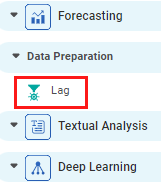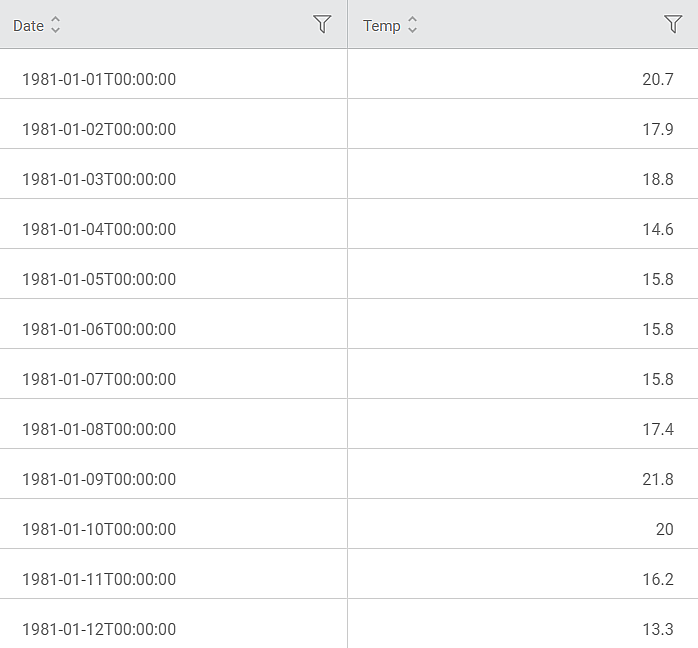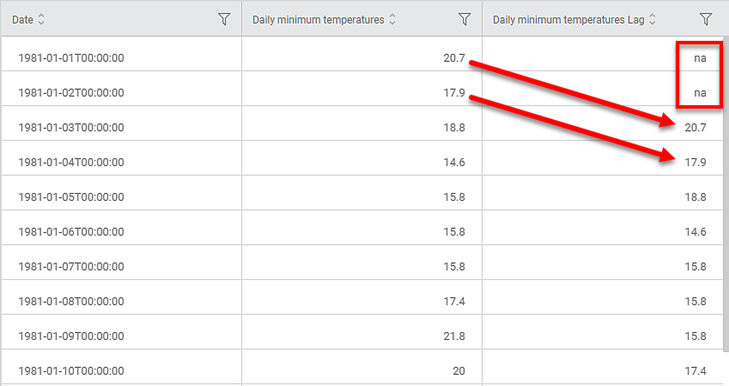Lag | |||
Description | Lag, also called the sliding window method, is a backshift operator function. The window width is the number of places the data points are shifted. | ||
Why to use | Lag is used to create a new list of data points by shifting them by an integral number of places. | ||
When to use | To create a shifted list of variables | When not to use | When the data does not contain trend or seasonal factor |
Prerequisites | The dataset should contain at least one data point. | ||
Input | Any time-series data | Output | Dataset with values moved to successive positions |
Statistical Methods Used | — | Limitations | — |
Lag is located under Forecasting ( ) in Data Preparation, in the left task pane. Use the drag-and-drop method to use the algorithm in the canvas. Click the algorithm to view and select different properties for analysis.
Refer to Properties of Lag.
In Lag, no aggregation is performed on the data. The data points are shifted by an integral number of places.
The lag function is also called the sliding window method. The window width indicates the number of places the data points are shifted.
For example, a width of one (1) indicates that in the Lagged column,
- the first entry is NA
- subsequent entries are the same as the original column with a shift of one place. Hence in the Lagged data column, the subsequent rows are filled with the values from the previous row in the original column.
Properties of Lag
The available properties of Lag are as shown in the figures given below. Figure 2 below shows the basic configurations for Lag.
The table given below describes the different fields present on the properties of Lag.
Field | Description | Remark | |
|---|---|---|---|
Task Name | It is the name of the task selected on the workbook canvas. |
| |
Time ID Variable | It allows you to select the time variable. | The dataset should contain at least one time variable. | |
Target Variable | It allows you to select the variable for performing the Lag. | The variable selected should be discrete. | |
Group By | It allows you to select the function for grouping identical data. |
| |
Advanced | Interval | It allows you to select the interval you want to calculate the Lag. |
|
Start Time | It allows you to select the time beginning which the data is sliced. | By default, the value is None. | |
End Time | It allows you to select the time ending in which the data is sliced. | By default, the value is None. | |
Lag | It allows you to select the number by which the data points are shifted |
| |
Node Configuration | It allows you to select the instance of the AWS server to provide control on the execution of a task in a workbook or workflow. | For more details, refer to Worker Node Configuration. | |
Example of Lag
Consider a Temperature dataset with 10 records. It contains columns for Date and corresponding daily temperature. A snippet of the input data is shown in the figure below.
We apply Lag to the input data. The selected values for Lag are given below.
Property | Value |
Time ID Variable | Date |
Target Variable | Temp |
Group By | — |
Interval | Day |
Start Time | None |
End Time | None |
Lag | 2 |
On the Data pane, you see that
- the first two values in the Temp Lag column are 'na.'
- Values in the Temp column are shifted two places in the Temp Lag column
Table of Contents



